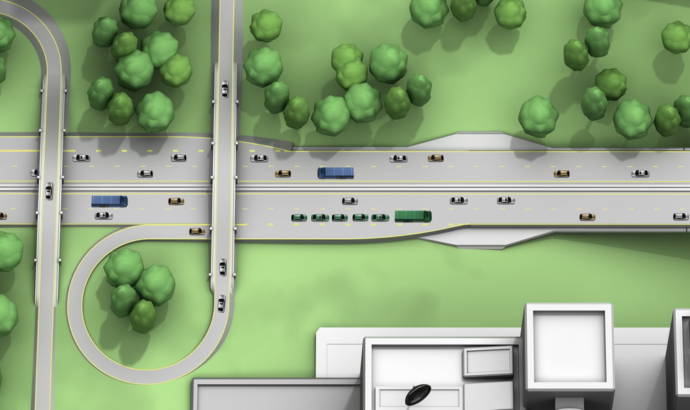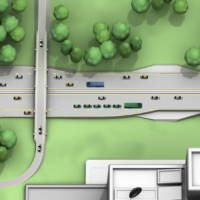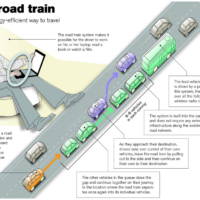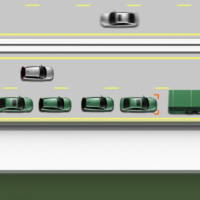Volvo announced that a new project called SARTRE is being launched in the European Union that will test technology for cars that can drive themselves. Apparently by having cars that are able to exclude the person behind the wheel from the task of driving then traffic flow and journey times can be improved plus accident rates will be lowered.
The study also shows that by having cars that drive themselves an improvement in fuel consumption and CO2 emissions will be noticed as well as an increase in the level of comfort for drivers.
Volvo says the idea of autonomous driving can be explored when a car joins the motorway and meets with other vehicles that are close to eachother, travelling at normal speed in a close-formation convoy. That is when the active technology kicks in allowing the driver to do things like read the newspaper, talk on the phone or watch TV.
Even though it might sound like science fiction Volvo claims that cars that drive themselves can become reality within 10 years and the first test vehicle equipped with this technology will roll on test tracks in 2011.
Volvo press release :
A new EU project SARTRE is being launched to develop and test technology for vehicles that can drive themselves in long road trains on motorways. This technology has the potential to improve traffic flow and journey times, offer greater comfort to drivers, reduce accidents, and improve fuel consumption and hence lower CO2 emissions.
Just imagine leaving home in the morning and, just after joining the motorway, meeting up with a number of other cars which inch up to each other, travelling at normal speed in a close-formation convoy. After a few minutes you can let go of the steering wheel and spend your time reading the morning paper, talking on the phone or watching the TV, while your car drives itself in complete safety and also saving fuel! A vision of a motoring Utopia?
Not if you believe today’s researchers who suggest that road trains can become reality within a decade.
The automotive industry has long been focused on the development of active safety systems that operate preventively, such as traction control and braking assistance programs. But automakers have also gone much further in proposing technology that allows vehicles to be operated without any input whatsoever from the person behind the wheel. Known as autonomous driving, this technology means that the vehicles is able to take control over acceleration, braking and steering, and can be used as part of a road train of similarly controlled vehicles.
The first test cars equipped with this technology will roll on test tracks as early as 2011. The vehicles will be equipped with a navigation system and a transmitter/receiver unit that communicates with a lead vehicle. Since the system is built into the cars, there is no need to extend the infrastructure along the existing road network.
Cars that drive themselves vide :
Lead vehicle
The idea is that each road train or platoon will have a lead vehicle that drives exactly as normal, with full control of all the various functions. This lead vehicle is driven by an experienced driver who is thoroughly familiar with the route. For instance, the lead may be taken by a taxi, a bus or a truck. Each such road train will consist of six to eight vehicles.
A driver approaching his destination takes over control of his own vehicle, leaves the convoy by exiting off to the side and then continues on his own to his destination. The other vehicles in the road train close the gap and continue on their way until the convoy splits up.
Many advantages
The advantage of such road trains is that all the other drivers in the convoy have time to get on with other business while on the road, for instance when driving to or from work. The road trains increase safety and reduce environmental impact thanks to lower fuel consumption compared with cars being driven individually. The reason is that the cars in the train are close to each other, exploiting the resultant lower air drag. The energy saving is expected to be in the region of 20 per cent. Road capacity will also be able to be utilised more efficiently.
"The SARTRE project brings together a unique mix of technologies, skills and expertise from European industry and academia, with the aim of encouraging the development of safe and environmentally effective road trains," explains Tom Robinson, SARTRE project coordinator, of Ricardo UK Ltd. "By developing and implementing the technology at a vehicle level, SARTRE aims to realise the potentially very significant safety and environmental benefits of road trains without the need to invest in changes to road infrastructure."
"I do appreciate that many people feel this sounds like Utopia", says Erik Coelingh, technical director of Active Safety Functions at Volvo Cars. However, this type of autonomous driving actually doesn’t require any hocus-pocus technology, and no investment in infrastructure. Instead, the emphasis is on development and on adapting technology that is already in existence. In addition, we must carry out comprehensive testing to verify our high demands on safety."
Researchers see road trains primarily as a major benefit to commuters who cover long distances by motorway every day, but they will also be of potential benefit to trucks, buses, coaches vans and other commercial vehicle types.
As the participants meet, each vehicle’s navigation system is used to join the convoy, where the autonomous driving program then takes over. As the road train approaches its final destination, the various participants can each disconnect from the convoy and continue to drive as usual to their individual destinations. Source: Volvo






